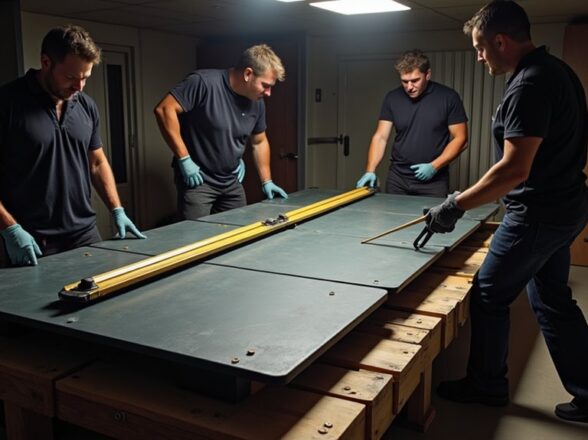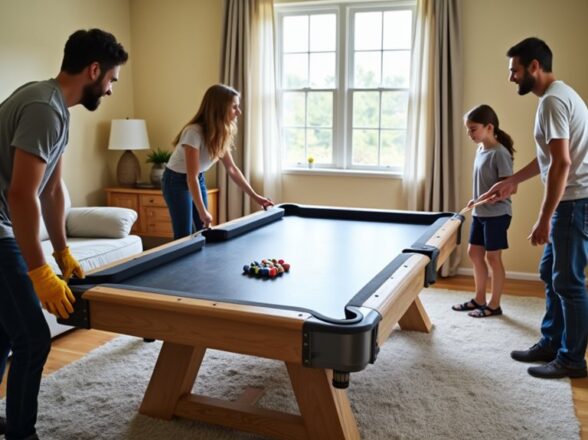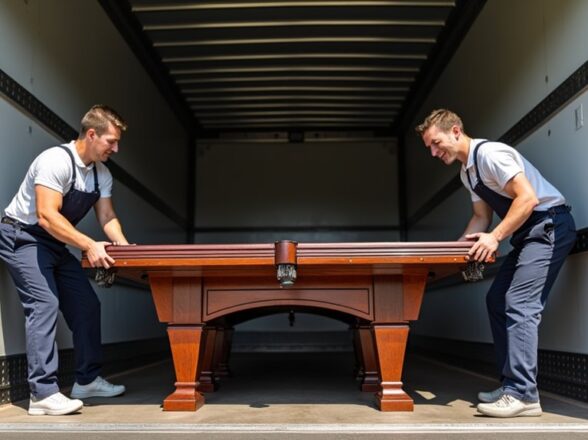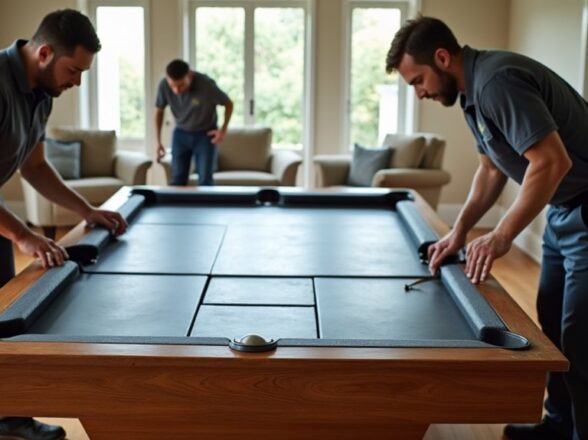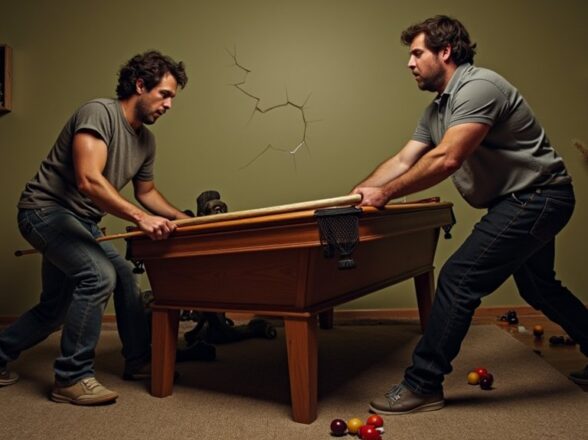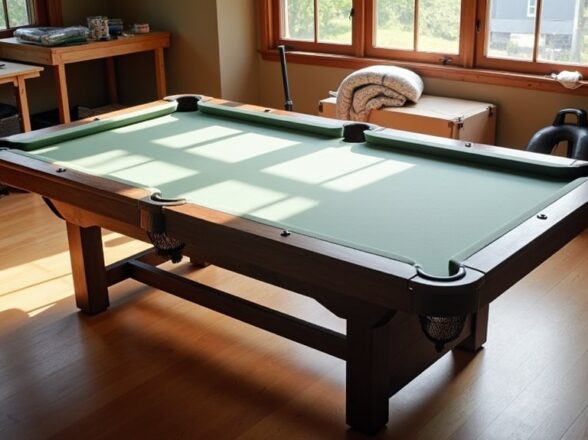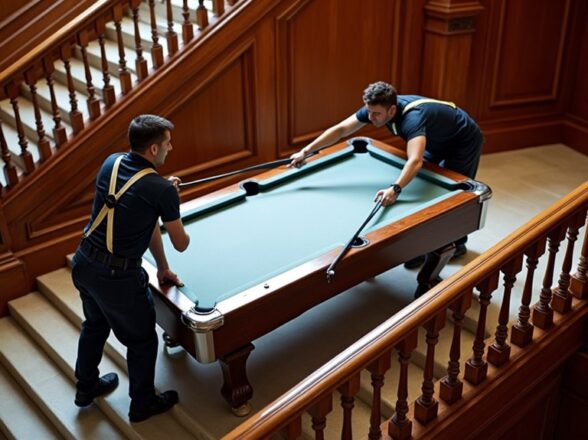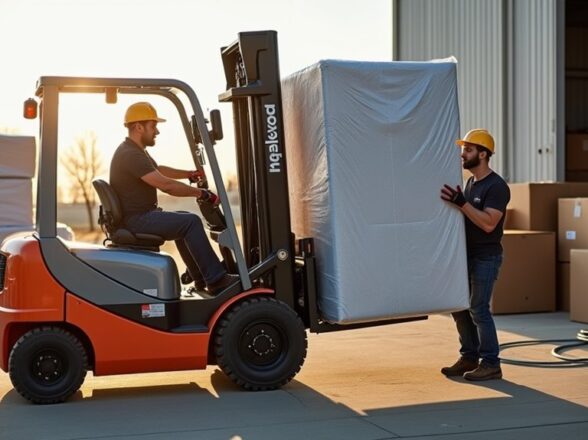What Are the Best Tools and Equipment for Moving a Pool Table? Must-Have Items for Safe Transport
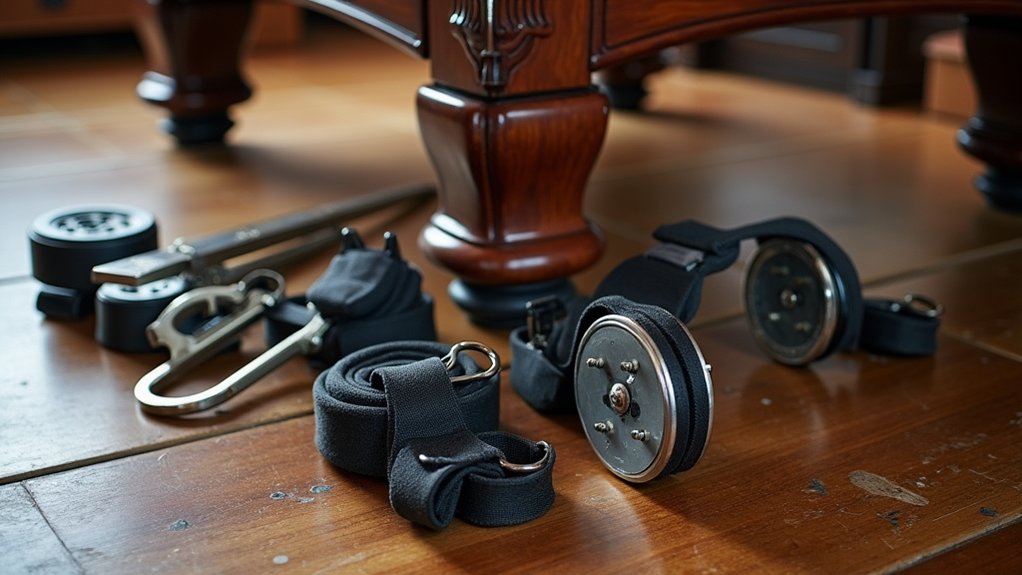
To move a pool table safely, gather essential tools like a socket wrench, flathead screwdriver, and power drill for disassembly. Use furniture dollies and a hand truck for transporting heavy slate pieces. Protect all components with heavy-duty moving blankets and bubble wrap. Straps or ropes will secure pieces in the vehicle to prevent shifting. Choose a moving truck or van that accommodates the table's size and weight. Verify you have a clear plan for disassembly and reassembly, with parts labeled for easy setup later. Master these steps to tackle your move effectively and efficiently, and more tips await.
Importance of Proper Preparation
When you're moving a pool table, proper preparation is essential to secure a smooth and safe process. Start by measuring the dimensions of the pool table and the areas it must pass through, like doorways and staircases. This careful planning helps you avoid complications. Next, gather necessary tools such as a socket wrench and flathead screwdriver before you disassemble your table. Clearing the area around the table of obstacles also minimizes risk and prevents accidents. Using moving blankets will protect your table during transport. Finally, create a detailed moving plan, including a checklist of steps and tools. This organization enhances efficiency and guarantees safe transport, making the entire moving experience much smoother.
Essential Tools for Disassembly
When disassembling a pool table, having the right tools makes the process smoother. You'll need a socket wrench for the side rails and legs, and a flathead screwdriver for pockets. A power drill can help with slate removal, but use it carefully to avoid damage.
Recommended Tool Types
Disassembling a pool table requires a few essential tools that make the process smoother and safer. A socket wrench is crucial for unscrewing the bolts on the legs and rails. You'll also need a flathead screwdriver to remove the pockets and screws without damaging the table. A power drill is helpful for detaching the heavy slate sheets from the frame. Once disassembled, use furniture dollies to transport the heavy pieces safely, reducing the risk of injury. To protect each component during transport, wrap them in moving blankets and bubble wrap. These protective materials guarantee that your pool table remains scratch-free and secure while being moved. Having the right tools will simplify your disassembly and transport experience.
Proper Usage Tips
To guarantee a smooth disassembly process, it is crucial to use your tools correctly. Start with a socket wrench to remove the bolts and screws holding the pool table's rails and legs. Next, use a flathead screwdriver to detach pockets and any screws on components. The power drill is key for carefully removing heavy slate pieces, preventing cracks or chips. A staple remover helps you gently take off the felt, ensuring it can be reused later. While moving, employ lifting straps to distribute weight evenly and reduce strain. Prepare with moving blankets and packing tape to protect surfaces. Finally, use furniture sliders for easy movement and bubble wrap to safeguard delicate parts during transport.
Protective Equipment for Transport
Protecting your pool table during transport is essential to avoid costly damage. Start by using heavy-duty moving blankets to wrap the table and its components. This provides cushioning and prevents scratches or dents. For delicate parts like the slate and rails, bubble wrap is vital to absorb shocks and prevent cracking. When moving the table, furniture sliders can help you glide it across floors easily, reducing strain and protecting the surface underneath. Straps or ropes are necessary to secure the pieces inside the vehicle, preventing shifting during transport. Finally, a dolly or hand truck is essential for moving heavy slate pieces, ensuring the weight is evenly distributed and reducing the risk of injury.
Safe Moving Techniques
When moving a pool table, using safe techniques is essential to prevent injury and damage. You should always lift heavy pieces correctly by bending at your knees and keeping the load close to your body. Additionally, securing all parts during transport and ensuring clear pathways will help make the process smoother.
Proper Lifting Techniques
As you prepare to move a pool table, mastering proper lifting techniques is essential for guaranteeing safety and efficiency. Follow these steps:
- Lift the slate and heavy parts using your legs. Keep your back straight and bend at the knees to avoid injury.
- Use a dolly or hand truck for transporting these heavy items. Secure the load with moving blankets and straps to prevent shifting.
- Enlist at least one additional person for lifting and maneuvering. Teamwork helps maintain balance and reduces the risk of dropping items.
- Practice proper grip techniques by keeping your hands dry and using gloves if necessary. This guarantees a secure hold, especially when handling heavy slate pieces.
- Consider disassembling common furniture types when moving large items like pool tables, as this can simplify transportation and help prevent damage.
Secure Load Handling
To guarantee a safe moving experience, securing your load is crucial, especially with heavy pool table components. Use furniture dollies to transport heavy components like the slate and frame, as they reduce physical strain and minimize the risk of dropping parts. Lifting straps can help properly distribute weight, allowing multiple people to lift and maneuver the table safely. Always secure items in the moving vehicle using a strap or rope to prevent shifting during transit. When traversing stairs or tight spaces, communicate clearly with your helpers to coordinate movements. Remember to lift with your legs and maintain proper posture to avoid back injuries, especially when handling heavy slate pieces that can weigh over 450 pounds. Consider seeking assistance from professional movers who are equipped with specialized tools and expertise for handling such heavy and delicate items safely.
Safe Transport Practices
Making certain your pool table components are safely transported requires careful planning and execution. Follow these safe transport practices:
- Use a furniture dolly or hand truck for heavy slate pieces to minimize injury risks.
- Wrap delicate components like the slate and rails in moving blankets or bubble wrap to prevent scratches.
- Secure all disassembled parts in the vehicle using straps or ropes to avoid shifting during transport.
- When maneuvering stairs or tight spaces, enlist the help of multiple people to lift and maneuver the heavy pieces.
Drive cautiously and avoid bumpy roads to guarantee a smooth transit. Implementing these safe transport techniques will help protect your pool table and make your move successful.
Choosing the Right Vehicle
Selecting the right vehicle is essential when moving a pool table. You'll need a moving truck or van that accommodates the full dimensions of the table and its disassembled parts. Pool tables can weigh between 600 to 1,000 pounds, so guarantee there's ample space for safe transport. Look for a vehicle with a flat loading surface and a ramp to make loading and unloading easier, especially for heavy slate slabs. A clean interior is important too; it prevents scratches during transit. Check for tie-down points or straps to secure the components, preventing any shifting while on the road. Finally, plan your route ahead of time to avoid obstacles for a smooth and safe journey.
Reassembly Best Practices
Reassembling a pool table requires careful attention to detail to verify stability and ideal gameplay. Follow these best practices for a smooth reassembly:
- Start by securely attaching the legs to the table frame, verifying they're tightened properly for stability.
- Lay the slate pieces back onto the frame, using a carpenter's level to verify they're flush and level.
- Reinstall the felt, making sure it's stretched evenly across the surface and stapled down to avoid wrinkles.
- Reattach the side rails with screws, double-checking all connections for stability before moving on to the next step.
Finally, install the pockets in their designated locations, verifying they're securely fastened to prevent any issues during use.
Maintaining the Pool Table
To keep your pool table in top condition, regular maintenance is essential for preserving its quality and longevity. Start with a regular clean of the felt using a vacuum designed for pool tables to remove dust and debris. This helps prevent wear and maintains the surface. Inspect the table periodically for loose screws or bolts and tighten them to guarantee stability during play. Keep the table away from direct sunlight to prevent fading or warping. Schedule professional maintenance annually to address any wear or damage, which can prolong the table's lifespan. Finally, avoid placing heavy objects on the table when not in use, as this helps maintain its structural integrity and keeps it ready for your next game.
When to Hire Professionals
Even with proper maintenance, there comes a time when you may need to move your pool table, and knowing when to hire professionals can make all the difference. Consider hiring a professional when:
- You have a heavy slate pool table weighing between 600 to 1,000 pounds.
- Maneuvering tight spaces, stairs, or complex layouts is necessary.
- The table holds significant financial or sentimental value, and you want proper handling.
- You need to expedite the moving process due to time constraints.
Professional movers have the experience and equipment to manage these challenges and often carry insurance against damages. This guarantees your pool table is relocated efficiently and safely, preserving its integrity during transport. Additionally, hiring a piano specialist ensures safe transportation, similar to how experts carefully handle pianos to prevent damage.
Frequently Asked Questions
What Tools Do You Need to Move a Pool Table?
To move a pool table, you'll need assembly tools for the disassembly procedure, lifting straps for weight distribution, a dolly cart for transport, protective padding to prevent damage, and a suitable transport vehicle for safety precautions.
How to Safely Move a Pool Table?
Moving a pool table's a challenge, but with proper techniques, you can guarantee safety. Focus on disassembly, use padding materials, coordinate your team, and follow reassembly tips to prevent damage and maintain weight distribution.
What Materials Are Used for Pool Table?
You'll find pool table materials include slate for durability, wood for frame construction, and felt for smooth play. Cushion rubber enhances ball movement, while leg designs and finish options affect stability and aesthetics during assembly.
What Tools Do You Need to Level a Pool Table?
How can you guarantee your pool table's perfectly level? You'll need a bubble level, shims for adjustments, tools for precision measurement, and follow installation guidelines to avoid common mistakes with leg supports and slate adjustments.
Conclusion
Moving a pool table requires careful planning and the right tools. Did you know that nearly 70% of pool table moves result in damage if not done properly? Using essential equipment and safe techniques can help prevent this. Whether you choose to do it yourself or hire professionals, ensuring proper preparation is key. Follow best practices during transport and reassembly to maintain your pool table's condition. With the right approach, you can enjoy your table for years to come.
Related posts
Recent posts
Post Categories
Tags
Subscribe

